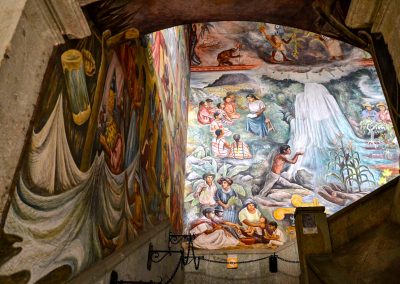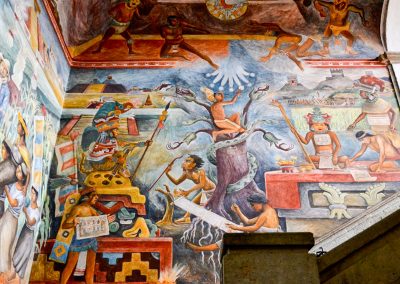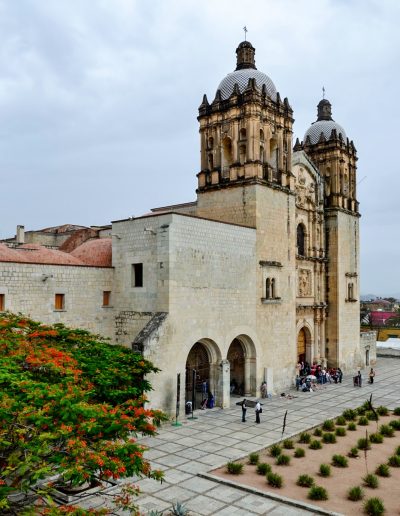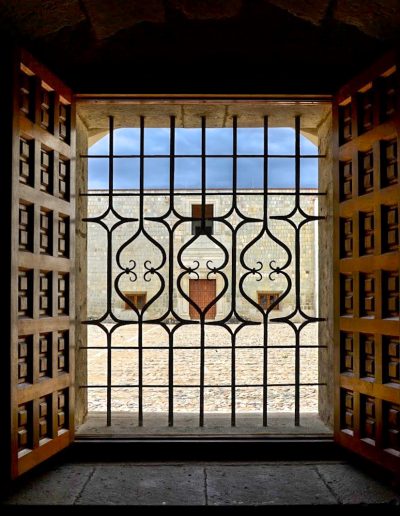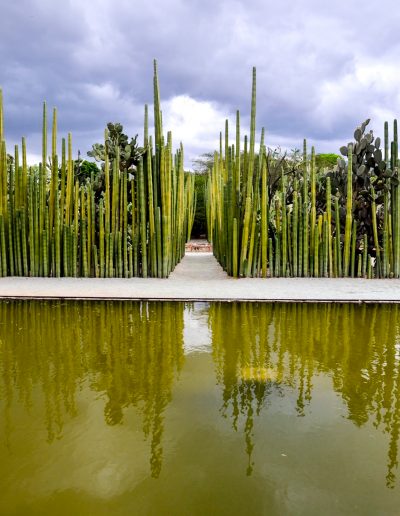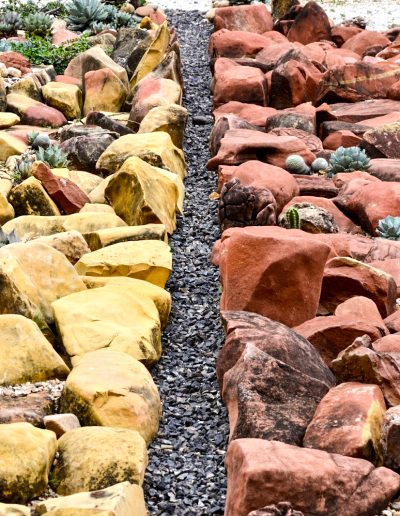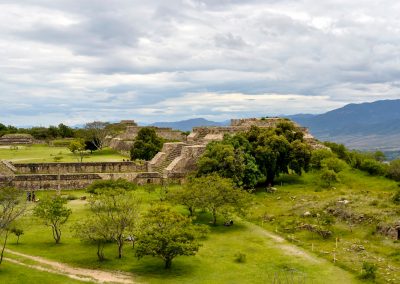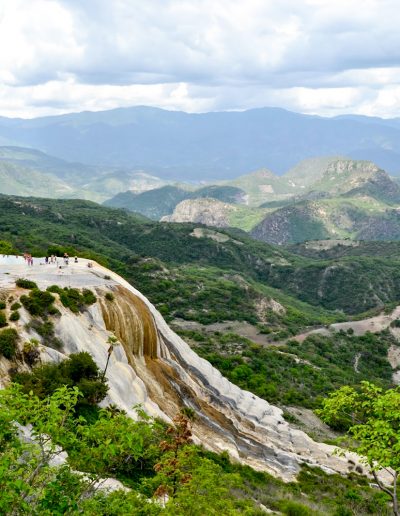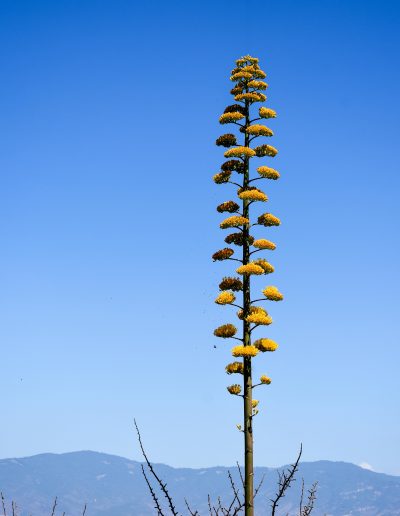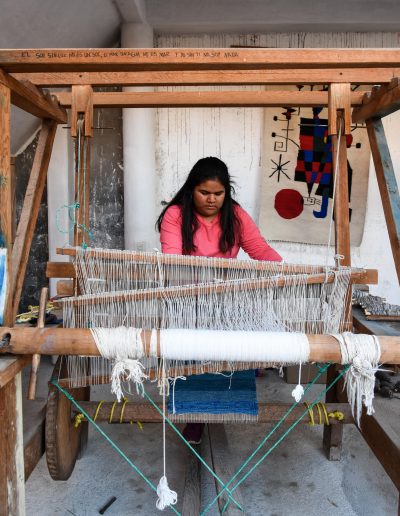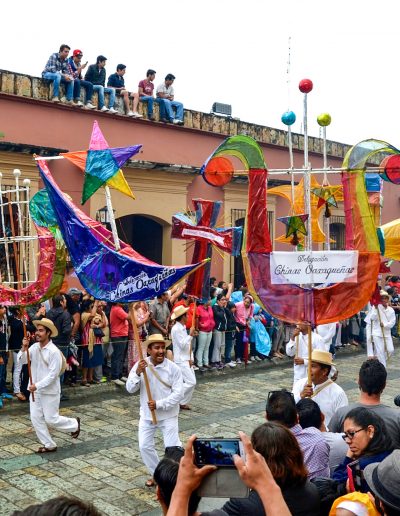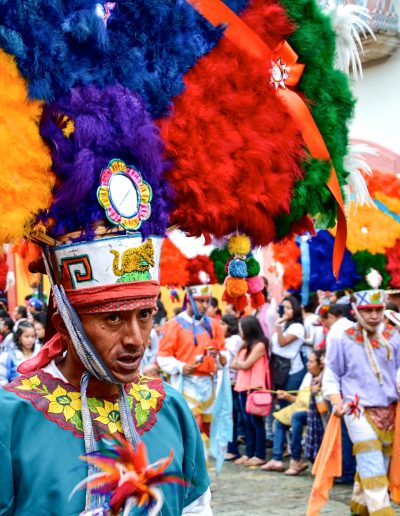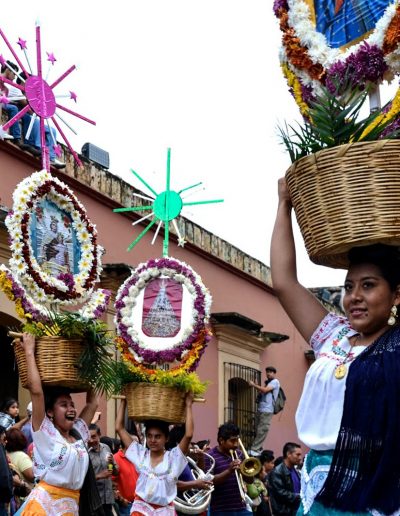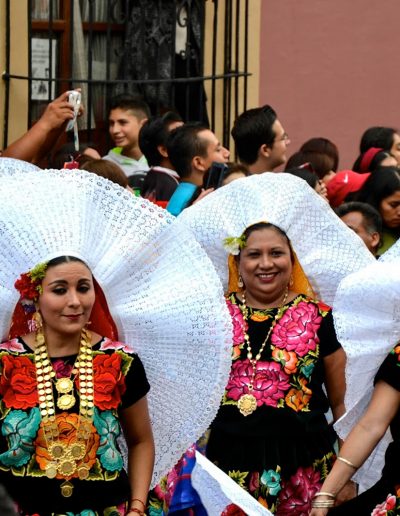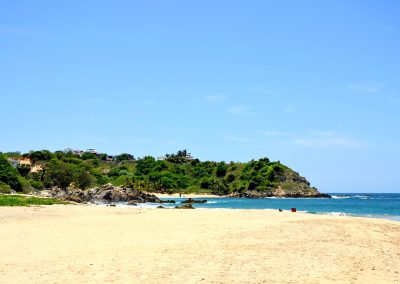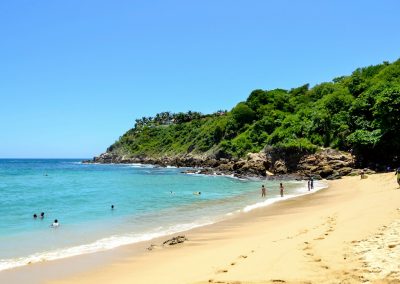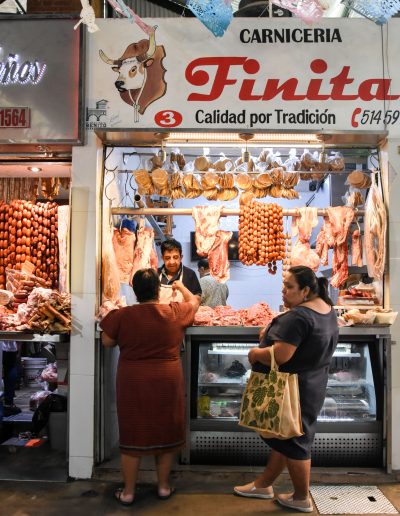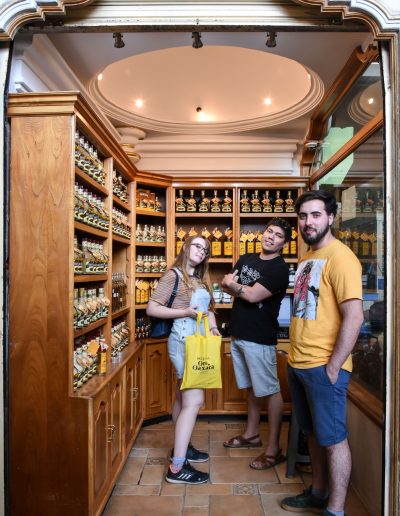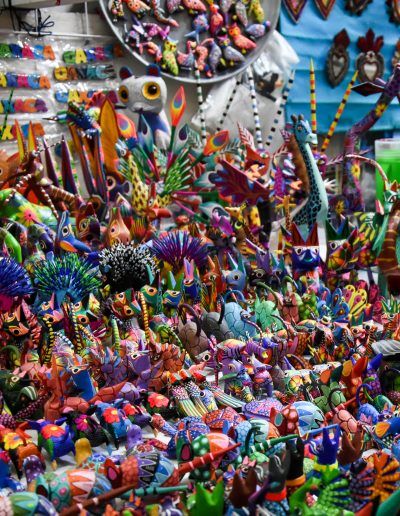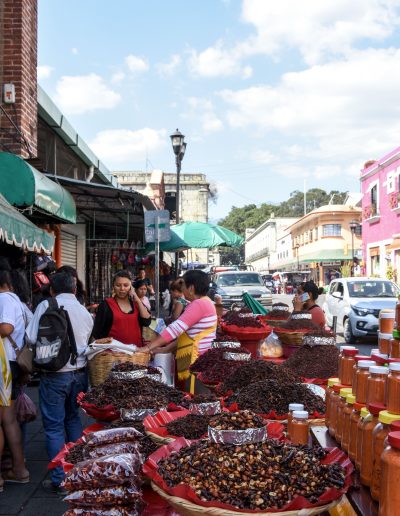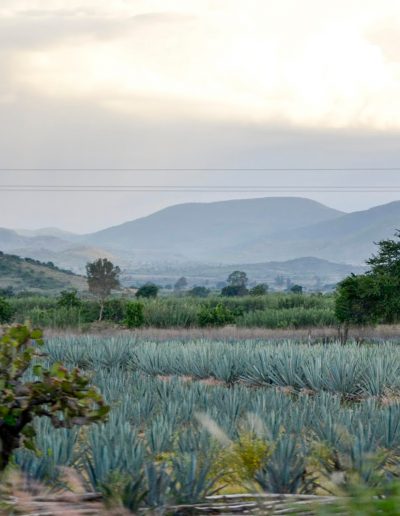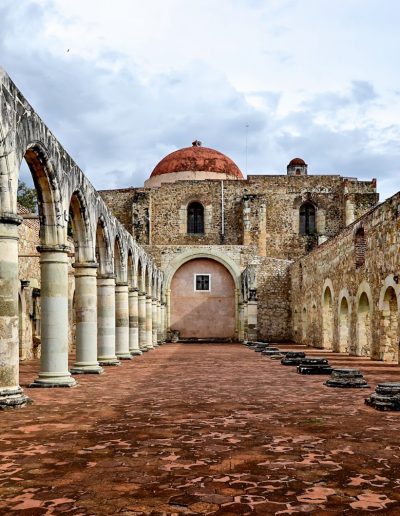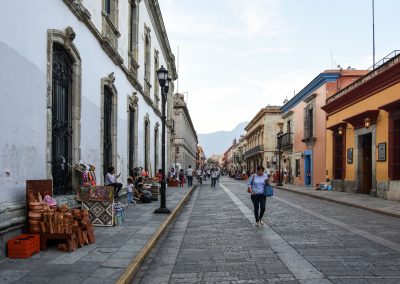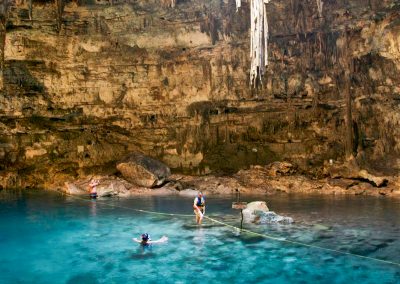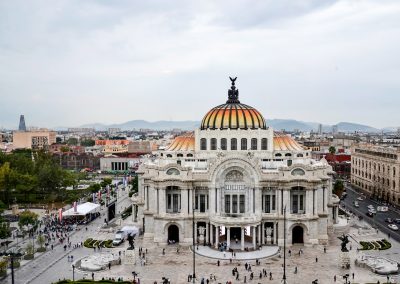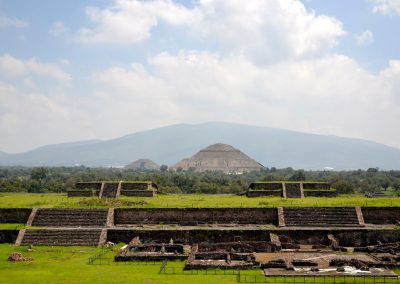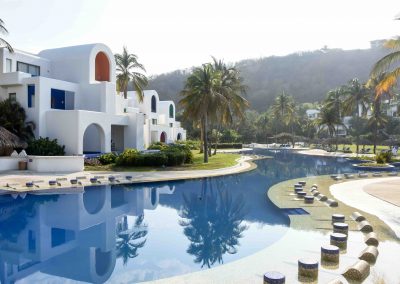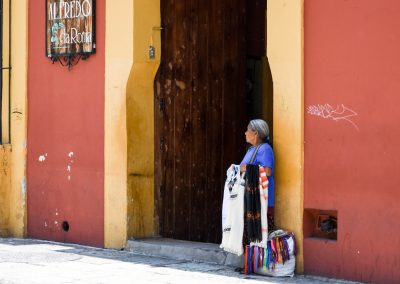When I say that I lived in Mexico, I say that I lived in Mérida, but in fact I have spent as much time in the state of Oaxaca as in Mérida. As my husband comes from its capital, Oaxaca de Juárez, whenever we go to Mexico, we go to Oaxaca to visit the family. The state of Oaxaca is one of Mexico’s cultural and gastronomic highlights and offers a lot to do!
The city of Oaxaca de Juárez itself is a pearl of colonial architecture, a UNESCO World Heritage Site! Located in a valley, with the Sierra Madre surrounding it, it offers from its “andador turistico”, a beautiful avenue without cars, which connects two of the most important squares in the city, to art galleries, historic churches or fascinating museums! But beyond the city there is also a lot to discover, either half an hour away or a 7 hour drive (yes, the state is as big as mainland Portugal) – old Zapotec cities, paradisiacal beaches or even the opportunity to swim in a petrified waterfall!
Zócalo of Oaxaca
It is impossible to visit the city of Oaxaca without visiting its main square! Although not the most beautiful, mainly because it is always full of camped protesters, for one reason or another, it is impossible to avoid it. It is a place full of life, full of street vendors, informal markets that sell clothes or handicrafts to tourists and locals, many balloons, food carts and several restaurants with terraces scattered through the arcades on both sides of the square.
On the south side of the Zócalo is the Palacio de Gobierno (hence the choice of place for the demonstrations). The building is open to the public and contains an interesting and interactive science museum (entrance 25$MX, free on Sundays), beautiful murals that tell the story of Oaxaca and some of its most important characters, like Benito Juárez who gives his name to the city, as well as temporary exhibitions.
On the north side of the Zocalo is the Cathedral of Nuestra Señora de la Asunción. It is common to find celebrations in front of the cathedral’s door, especially in the month of July, when the Guelaguetza festivities are approaching, with music, dances and even fireworks.
Santo Domingo – Square, Temple, Museum and Ethnobotanical Garden
Santo Domingo for me is Oaxaca! At the top of andador turistico, this is where the greatest beauty of the city lies, the Santo Domingo de Guzmán Temple, with its large square full of agave cacti and street vendors! The interior of the church is just as impressive as its exterior! Passing its huge doors we find a vault covered with gold, in fact the entire interior is full of golden decorations!
To the left of the church entrance we find the entrance to the Santo Domingo Cultural Center, a museum that exhibits pieces from the various cultures that have step on Oaxaca throughout the ages, all framed by the beautiful ex-convent from the 17th century! Even if there is little interest in the museum, it is quite interesting to walk through these old cloisters and corridors with large windows to the neighboring Ethnobotanical Garden. Entrance to the museum costs 70$MX and it is open from Tuesday to Sunday, from 10am to 6:30pm (on Sunday admission is free).
The Garden is for me another of the highlights of the city, it is a pity that it is not an integrated park in the city, but a tourist attraction. Here we find several cacti, strange trees that only exist in these latitudes and several sculptures scattered around the garden. But the most beautiful thing for me is the presence of the Santo Domingo convent as a backdrop for the garden! It is only possible to visit it with a guide, visits in Spanish cost 50$MX (from Monday to Sunday, at 10am, 12pm and 5pm), visits in English cost 100$MX (Tuesdays, Thursdays and Saturdays at 11am).
Monte Albán
A little less than 10km from the center of Oaxaca, on a hill overlooking the city, we find the ruins of the ancient city of Monte Alban, a UNESCO World Heritage Site. One of the first with an urban plan and the most important pre-Columbian city in the region, it was here that the political center of the Zapotecs was located, very influenced by the Teotihuacans at the beginning. At its peak it reached 35,000 inhabitants! After the fall of the Zapotec civilization, the entire region was dominated by the Mixtec people. It will be the best half-day tour to do “out of town”, it costs 80$MX and is open every day from 8am to 5pm.
It is relatively easy to reach Monte Albán by public transport, either by taxi or by shuttle, which departs from the Zócalo every half hour or every hour depending on the day of the week, tickets cost 60$MX roundtrip and are purchased on the west side of the square, on a stand in front of Subway. There is also the option to take a tour that in addition to including the visit to the ruins of Monte Albán, also includes the visit to Arrazola, a village known for its alebrijes, colorful sculptures of wooden animals (if you have seen the film Coco you will know what I am talking about ), a visit to Cuilapam convent and the village of Cuilapam itself, known for its black clay. It is possible to buy these tours online but it will be much cheaper to book with one of the guys who advertises them at the Zócalo.
Hierve el Água
Hierve el Água is one of the most popular tours to do from Oaxaca and for a good reason – imagine bathing in pools at the top of a petrified waterfall overlooking the immense Oaxacan mountains! Mineral-rich water flowing down the cliff of this mountain for thousands of years has developed these layers of calcium that elegantly go down the hill. The place has this name, not because the water is actually boiling but because when it comes out of the soil, it bubbles up, looking like it boils. In fact it is quite cold, ideal for a good bath on a very hot day, common in the region.
Entry costs 50$MX. Next to the parking lot there are dozens of places where it is possible to eat and drink – very important to be well hydrated! There are also changing rooms where it is possible to change to a bathing suit, if you aren’t wearing it from home. Then you have to go down the mountain for about 10 minutes until you reach the pools. It is also possible to wander (with or without a guide) to the top of the main waterfall or to see it from down below.
The easiest way to get to Hierve el Água is with a tour or with your own car – ideally 4×4 because the last time I went, in March 2020, the motorway was under construction and it was necessary to go up the mountain, through dirt paths. The tour, contracted with one of the boys from Zócalo, costs 200$MX (plus entrance fees) and supposedly includes the visit to these five points:
- Hierve el Água;
- Teotitlan del Valle, a Zapotec community known for its textiles;
- a Mezcal distillery in Matatlan;
- the archaeological site of Mitla;
- the Árbol del Tule, the widest tree in the world.
Due to the coronavirus pandemic, both the Tree and the archaeological zone of Mitla were closed, so it was only possible to visit the first three points, giving the opportunity to spend two hours in Hierve el Água, perfect for those who want to enjoy the pools. The tour also “included”, for 150$MX plus drinks, lunch at a buffet restaurant with typical Oaxacan food.
Árbol del Tule
Did you ever think where the largest tree in the world would be found? I had never thought of it as well, but it is right here, 13km from Oaxaca, in the church square of the small village of Santa Maria del Tule. More than two thousand years old, the trunk of this huge Mexican cypress measures 58m in circumference and 14m in diameter. The Árbol del Tule is an interesting place to visit, but it is not worth to drive 20min from Oaxaca just to see it. It is preferable to include this stop on the way to one of the other attractions in the same direction, like the Mitla ruins, the petrified waterfalls of Hierve el Água or the Tlacolula Market. It is free to see the tree from afar, but it is possible to get closer by paying the amount of 20$MX.


Mitla
The ruins of Mitla, an hour away from the city of Oaxaca, was the religious center of the Zapotec civilization and are known for having a unique frieze in the country. Mitla, which in Nahuatl means “place of the dead”, was inhabited between 200 and 1521AD, when the Spanish invaded Mexico. This name, which invokes the hereafter, is rooted in the innumerable funeral sacrifices and ceremonies that took place there, reinforcing the role of “Vatican of the Zapotecs”, while, I recall, Monte Alban was its political center.
To visit the archaeological zone of Mitla it is possible to get there obviously by your own means, or else include it in one of the tours that leave the city, be it the tour I presented above, which includes the visit to Hierve el Água, or a shorter tour, half-day, which goes only to Mitla, with a short stop in Santa Maria del Tule to see the widest tree in the world.
The entrance to the archaeological zone has a value of 75$MX and is open every day between 8am and 5pm. Pay attention to the hours because the first time I tried to visit Mitla it was already closed and the second time it was closed due to the coronavirus pandemic, so it will have to be the third time that I will be able to visit them! In any case, it is possible to see a lot of the archeological site around its perimeter and visiting the church, with free access, which is in the center of the ruins. The village of Mitla is one of the five Pueblos Mágicos in the state of Oaxaca!
Guelaguetza
For me the best time to visit Oaxaca is at the end of July because Guelaguetza is celebrated, the biggest festival of culture and dance in the state of Oaxaca. There is party everyday, from concerts and exhibitions, to different mezcal, food or handicraft markets, both on the street and in the large auditorium of Guelaguetza, where many Oaxacan delegations parade on the last two Mondays of July.
On Saturdays prior to the important Mondays, the same delegations parade through the center of Oaxaca, giving everyone the opportunity to see this beautiful spectacle – the monos of calenda pass, the Chinas Oaxaqueñas start, with their colorful skirts and huge baskets decorated on the head, the multiple tehuantepec delegations, with their embroidered dresses and huge gold necklaces, the Huautla delegation, also a Pueblo Mágico, with men dressed in white and women with pink and blue fallen dresses on a white background, then comes the Danza de la Pluma, only men, or Danza de Flor de Piña, only women, who dance with pineapples, among many others. There are many colors, there are turkeys, there is music, an event not to be missed!
Another of the shows that takes place in the Guelaguetza auditorium is that of Princesa Donaji. The story goes that Zapotec king Cosijoeza and Queen Coloyocaltzin had a son, Cosijopi, who was sent to rule the area of the Istmo of Tehuantepec. Cosijopi had a daughter, Princess Donaji. At that time, there were constant wars between the Zapotecs, established in Zaachila, the political capital of the Zapotecs at that time, and the Mixtecas, established in Monte Albán, after the Zapotecs left that place. The Mixtecas attacked Zaachila and, to end the war, took Princess Donaji hostage for peace. Then, the Zapotecs attacked Monte Alban, and because it was a sudden attack, the Mixtecas fled and beheaded the princess, only confessing where the body had been buried, but not revealing where the head was hidden, thus remaining a secret that later gave rise to the legend. The legend of Pricess Donaji says that a young shepherd took animals to graze to San Agustin de las Juntas, near the current international airport of the city of Oaxaca, and there he found a lilly flower. Instead of pulling it out, he started digging in order to take it with everything and root. He discovered that the root sprouted from a human ear, continued to dig and found an entire head. It is said that the head was in perfect condition and, because of the rich decorations, it was attributed to Princess Donaji. Then the body and head were buried in the temple at Cuilapam. It is believed that this was done to attract more indigenous peoples due to the importance of the character in the local culture, even because, officially, Princess Donaji was baptized with the name of Juana Cortés.
Oaxacan Beaches
The state of Oaxaca has a whole paradise coast to explore! The only negative point is that, to get there, it takes more than six hours through the Oaxacan mountains, either by car or by bus (these can take between 9 and 12 hours, but are usually by night, which ends up saving you one night accommodation) – or fly to Puerto Escondido or Huatulco airports. So, to consider going to these Pacific Ocean beaches, you have to add some extra days tou your vacation, which will be totally worth it! You can count on beautiful golden sand beaches and calm bays, escapes for surfers, such as Puerto Escondido, ideal places for those more ecologists, who want to see turtles in their natural habitat, like Mazunte, another of the five Pueblos Mágicos in Oaxaca, quieter villages like Puerto Angel or more exclusive places, like the all-inclusive resorts in Huatulco.
I visited Puerto Escondido, on my birthday in 2015, and Huatulco, on vacation last year. I recommend both, as they are so different.
The first destination is much more affordable. I recommend to stay at Aldea del Bazar, a good and inexpensive hotel. Puerto has several beaches, the most famous of which is Zicatela, where all the surfers are and where there are also numerous restaurants along the waterfront. But there are several other smaller and welcoming beaches like Carrizalillo or Manzanillo. To have a good breakfast, I recommend going to El Cafécito, Jorge’s favorite place to start the day!
In Huatulco, I stayed at the Camino Real Zaashila, three days on an all-inclusive basis, in a room with a private pool, so there wasn’t that much need of leaving the hotel. Still, it is worth visiting the neighboring city of Crucecita, with the church that contains the largest virgin of Guadalupe in the world – painted on the ceiling from one end of the church to the other – or to see the beach, publicly accessible, full of people sitting and eating in restaurants that occupy the beach all the way to the water, frightful. Huatulco is known for its bays because the “open sea” beaches are too dangerous in the region. Unfortunately our hotel, despite being in a bay, was right in front of its entrance, so it took all the swell. If you love swimming pools and mango margaritas, I suggest you stay there, if you are looking for beach and sea bathing, it is better to choose another hotel.
Markets – Benito Juarez Maza / 20 de Noviembre and Tlacolula de Matamoros
As you know, if you already follow this blog with some regularity, for me a visit to a market is essential in a visit to a new culture! And why not visiting two? No visit to Oaxaca would be complete without going through one of its busy markets. A great place to start this adventure is one block south of the Zócalo where you find the adjacent Benito Juarez Maza and 20 de Noviembre markets. It is an ecstatic scene that must be experienced even by those who have no intention of shopping. There, you can find practically everything, from spices and many different chillis, toys and piñatas, meat and seafood, chocolate, mezcal, clothes, flowers, local handicrafts and, of course, many chapulines – fried grasshoppers, of different sizes, just for the braver. It is also worth trying the Águas de Casilda, a spot that only sells águas frescas of innumerable flavors! I tried the guava and chia and it was divine! Open every day between 7am and 9pm.
For a real cultural experience, you have to drive about half an hour east of Oaxaca to reach the weekly market in Tlacolula de Matamoros. It is one of the oldest markets in Mesoamerica and one of the largest, not only in Oaxaca, but in the entire Mexico. Every Sunday the market is filled with people from all the nearby lands who come to buy or sell. In these places I feel that I’m in “pure Mexico”, the most traditional, where globalization has not yet arrived, where women dress and comb traditionally, where chickens and turkeys go upside down by the hand, where families meet to eat the meat they have just bought on the spot beside the grill, where the colors are mesmerizing! The market is almost an extension of the beautiful church, just next door, where almost everyone prays before or after shopping.
Mezcal and food
Oaxaca is known worldwide for the mezcal. Mezcal is a drink similar to tequila in that it is made from the agave plant, but mezcal is more complex, both in terms of taste and production. Many different types of agave are used for mezcal, while tequila is only produced with blue agave. In addition, the mezcal underground roasting process offers a smoky flavor, for which it is known. The mezcal should be drunk at room temperature and like “kisses”, sip by sip, and not as a shot. Sometimes mezcal is served with orange slices and sal de gusano, a mixture of salt, spices and smashed worms – the plague of agave plantations.
To really understand better what the mezcal is, you must go to the village of Matatlan, about 45 minutes from Oaxaca. It is here that many of the famous mezcal distilleries are located, where almost all offer a free tour through the production area and also the tasting of the various types of mezcals, as well as the most varied cremas de mezcal in so many flavors as you can imagine. Often, tours that go to Mitla or Hierve el Água also stop at one of Matatlan’s distilleries, especially in “El Rey de Matatlan”, where I have been.
Obviously, it is also possible to try mezcal in the city of Oaxaca, in almost any restaurant or bar. In the area of the Benito Juárez market (and even within the market), there are shops of mezcal brands and there you can also have a taste before buying anything!
Regarding typical food, Oaxaca has a variety of regional dishes, exclusive to this region. So I suggest you try these Oaxaca specialties when you have the opportunity to visit the city:
- Chapulines – For those brave enough! Fried grasshoppers, of various sizes, from the huge, obvious grasshopper, to the microscopic, that you can’t really see what it is! They are found in baskets by the Oaxaca markets and usually seasoned with chilli and lemon. If you manage to overcome the fact that you are eating insects, it appears they are great – I have never overcome the fact 😛 Oaxaqueños eat them as if they were lupins, accompanying a fresh beer, put them on top of various dishes, as if it was an aromatic herb, or even eat them at the cinema, as if they were popcorn!
- Quesillo – The typical cheese from Oaxaca, difficult to find in other regions of the country. This fine, white cheese is usually sold “in balls” and served in pieces. You can indulge in everything – quesadillas, tacos, tlayudas – or eat i alone and it is the best of Oaxaca for me!
- The 7 moles of Oaxaca – mole negro, mole amarillo, mole verde, mole coloradito, mole rojo, mole manchamanteles and mole chichilo. Moles are very complex dishes, a kind of sauce that mixes many spices and chillis – which depending on the mixture will give a different type of mole. The black mole (mole negro) is the best known and the most common, a mixture of sweet, of the chocolate it takes, and the spicy, of the more than 20 ingredients that it is composed of, and what gives it the black color is the chile chilhuacle. Also the red mole (mole rojo) and the green mole (mole verde) are easily found throughout the state.
- Tlayudas – This may be one of the most emblematic dishes in Oaxaca and if you think about it, it is like a giant quesadilla, with a slightly different tortilla. Tortillas with a diameter of about 40cm are filled with a variety of fried beans, quesillo, lettuce and avocado. Then, they are “grilled” open, to obtain a light and crunchy texture – I don’t like the burnt flavor they get … But for Jorge they are the best thing there is, absolutely delicious. They can also be eaten with a piece of …
- Tasajo – A cross between low salted dry meat and a skirt steak. This may not be the most appetizing description, but trust me when I say that tasajo is delicious! Tasajo can be found on many Oaxacan menus as an independent dish or as an ingredient inside the tlayudas. I usually eat inside quesadillas – with quesillo, of course!
And what else is there to do in or around Oaxaca? You can …
- Visit the Macedonio Alcalá Theater, which is located in the city center, a great example of modernist architecture with French influences, characteristic of the Porfiriato;
- Take a taxi to San Agustin Etla, 17km from Oaxaca, to visit CaSa, the San Agustin Arts Center. The building where it is located is of an old factory, La Soledad, founded in 1883. Not only is the recovery project beautiful, but the whole environment transports us to a happier place, since there are people playing classical music in every corner;
- See the city from Cerro del Fortín where the statue of Benito Juárez is located, one of the most important figures in the state and which gives the city its name;
- Visit the colorful neighborhood of Jalatlaco, where I took my photographs dressed in the typical Tehuantepec costume;
- Watch a baseball game by the Guerreros of Oaxaca. Between March and August at Eduardo Vasconcelos stadium, tickets are super affordable and it’s an afternoon well spent while learning about a new sport (at least for portuguese) while having the freshest Mexican beer!;
- Visit the former Dominican convent in Cuilapam de Guerrero. The building is beautiful and it was there that Vicente Guerrero, one of the leaders of the War of Independence, was arrested and shot and where the body and head of Princeja Donaji can also be found. The visit to the convent can also be included with the Monte Albán tour, as previously mentioned;
- Visit one of the five Pueblos Mágicos of Oaxaca (or all!) – Capulálpam de Mendez, in the middle of the Sierra de Juárez, a place of indigenous Zapotec roots; Huautla de Jiménez, in the Cañada Mazateca Region, is also known as the ‘Place of the Eagles’; San Pedro y San Pablo Teposcolula, mainly known as the place of historical monuments, preserves architectural jewels and traditions representing the best of mixtec culture; San Pablo Villa de Mitla, home to the impressive archaeological site with the same name; or Mazunte, which, as previously mentioned, is found on the Pacific Ocean coast and is recognized for being a sanctuary for sea turtles.
If you liked this post and want to read more about my trips to Mexico, you can visit the following posts:










